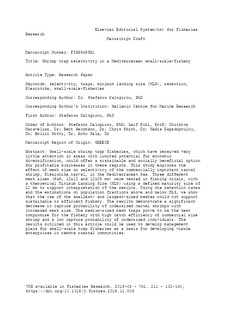| dc.contributor.author | Kalogirou, Soteris A. | |
| dc.contributor.author | Pihl, Leif | |
| dc.contributor.author | Maravelias, Christos | |
| dc.contributor.author | Herrmann, Bent | |
| dc.contributor.author | Smith, C. J. | |
| dc.contributor.author | Papadopoulou, Nadia | |
| dc.contributor.author | Notti, Emilio | |
| dc.contributor.author | Sala, A. | |
| dc.date.accessioned | 2019-04-15T18:22:01Z | |
| dc.date.available | 2019-04-15T18:22:01Z | |
| dc.date.created | 2018-12-02T21:14:02Z | |
| dc.date.issued | 2019-03 | |
| dc.identifier.citation | Fisheries Research. 2019, 211 (131.- 140) | nb_NO |
| dc.identifier.issn | 0165-7836 | |
| dc.identifier.uri | http://hdl.handle.net/11250/2594707 | |
| dc.description.abstract | Small-scale shrimp trap fisheries, which have received very little attention in areas with limited potential for economic diversification, could offer a sustainable and socially beneficial option for profitable businesses in these regions. This study explores the effect of mesh size on selectivity of the commercially important narwal shrimp, Plesionika narval, in the Mediterranean Sea. Three different mesh sizes (8 × 8, 12 × 12 and 12 × 25 mm) were tested in fishing trials, with a theoretical Minimum Landing Size (MLS) using a defined maturity size of 12 mm to support interpretation of the results. Using the retention rates and the estimations on population fractions above and below MLS, we show that the use of the smallest- and largest-sized meshes would not support sustainable or efficient fishery. The results demonstrate a significant decrease in capture probability of undersized narwal shrimps with increased mesh size. The medium-sized mesh traps prove to be the best compromise for the fishery with high catch efficiency of commercial size shrimp and a low capture probability of undersized individuals. The results outlined in this article could be used to develop management plans for small-scale trap fisheries as a basis for developing viable enterprises in remote coastal communities. | nb_NO |
| dc.language.iso | eng | nb_NO |
| dc.publisher | Elsevier | nb_NO |
| dc.rights | Attribution-NonCommercial-NoDerivatives 4.0 Internasjonal | * |
| dc.rights.uri | http://creativecommons.org/licenses/by-nc-nd/4.0/deed.no | * |
| dc.subject | Selectivity | nb_NO |
| dc.subject | Traps | nb_NO |
| dc.subject | Minimum landing size (MLS) | nb_NO |
| dc.subject | Retention | nb_NO |
| dc.subject | Plesionika | nb_NO |
| dc.subject | Small-scale-fisheries | nb_NO |
| dc.title | Shrimp trap selectivity in a Mediterranean small-scale-fishery | nb_NO |
| dc.type | Journal article | nb_NO |
| dc.type | Peer reviewed | nb_NO |
| dc.description.version | acceptedVersion | nb_NO |
| dc.source.pagenumber | 131 - 140 | nb_NO |
| dc.source.volume | 211 | nb_NO |
| dc.source.journal | Fisheries Research | nb_NO |
| dc.identifier.doi | 10.1016/j.fishres.2018.11.006 | |
| dc.identifier.cristin | 1638219 | |
| cristin.unitcode | 7566,2,0,0 | |
| cristin.unitname | Sjømatteknologi | |
| cristin.ispublished | true | |
| cristin.fulltext | postprint | |
| cristin.qualitycode | 1 | |

